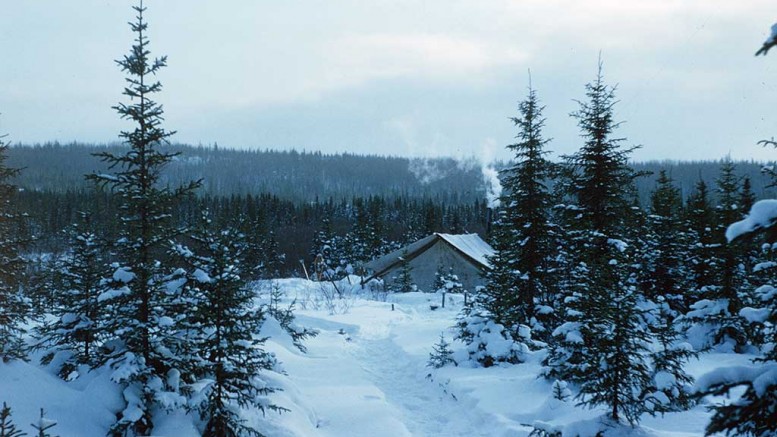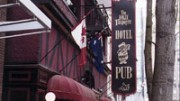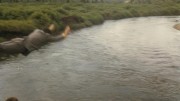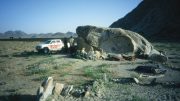My first winter in the bush, after graduating from MIT in June 1958 with a degree in geology and geophysics, began on Dec. 5, 1958. I flew from Toronto to Val-d’Or, Que., and joined other McPhar Geophysics employees at the Hotel Bourlamaque.
Zoran Jovanovic and I were scheduled for an electromagnetic (EM) survey at Doda Lake, 450 miles northeast of Toronto, and the others were going to the very active Mattagami area. Doda Lake is 150 miles southeast of Evans Lake, where I spent the previous summer and where I would return after the Doda Lake job.
The Fecteau air base wasn’t flying yet because of thin ice on the lakes and we had nothing to do but eat, read, walk around and wait for the next meal. Some of the guys used their expense accounts to keep their blood alcohol at a high level in preparation for the cold.

Christmas Day in 1958 in the Doda Lake area of Quebec: Zoran Jovanovic (left) and Harold Linder. Photo courtesy of Zoran Jovanovic.
Four days later Niels Anderson, a prospector, and Wally Baker, a handyman-prospector for the Jowsey mining interests, arrived and arranged for French claim stakers Art McKenzie and Adam Stayer to help us. We took a taxi to Senneterre and that night, which didn’t seem unusually cold, I saw an outside thermometer that read -47 degrees Fahrenheit. I guessed I was getting acclimated.
We left Fecteau’s just before dark in a Beaver piloted by Ross, our Evans Lake pilot. Flying in winter was much different than in summer, as the world below us was all black and white, and we hit several large hazes of ice crystals hanging in the air. We landed at Opemiska at 4:45 p.m. in complete darkness and went to the Opemiska Hotel, which was still under construction.
The restaurant wasn’t open for breakfast at 6:45 a.m., as scheduled, so the taxi driver went into the kitchen and cooked breakfast.
Then we flew in a Cessna on skis to a camp on Doda Lake, close to where the Opewica River flows east out of the lake. It seemed cold as hell, although it was only 15 or 20 below. This was probably mostly psychological, because we had left civilization and central heating behind.
Zoran and I hauled our gear two miles inland from the lake to the survey area on a toboggan and spent the day setting up a camp. This was my first experience on snowshoes, but I quickly got the hang of it by walking with my feet a little farther apart than normal, and pointing my toes inwards.
We spent a month doing EM and magnetic surveys at Doda Lake in temperatures at least as cold as -50 degrees Fahrenheit and spent both Christmas and New Year’s in the bush. Wood gathering was a chore, as our airtight wood stove had a voracious appetite, and it probably cost us at least an hour of precious daylight every day.

Our camp in the Doda Lake area of Quebec during the winter of 1958–1959. Photo by Harold Linder.
Zoran’s father had been a businessman in Yugoslavia who barely escaped with his life to Canada. In retaliation, the Communists harassed his family until they too could finally escape.
We had many long political discussions in our tent and Zoran could always get my attention when he started a story with the phrase “When my mother was in jail …”
We finished in mid-January and I returned to McPhar in Toronto. I completed a report on the Doda Lake job and learned a lot by listening to Stan Davidson and Phil Hallof interpret the results.
I also spent time at Dr. A.W. “Dink” Derby’s office downtown, and he decided I should spend a few more days at Doda Lake doing follow-up EM work. We also talked about the upcoming Evans Lake job, and how he was transforming his Derby Syndicate into a company named Deranco Mines.
The details and logistics necessary for geophysical bush work could be complicated, but a bit of planning could save a lot of money. A three-man crew doing EM cost $100 a day, an airplane trip cost $200 and my salary was only $400 per month.
We flew back to Doda Lake, spent a week detailing EM anomalies, and returned to the Hotel Ubald in Senneterre.
The Hotel Ubald was a rowdy place filled with Indians, prospectors and other people on their way into or out of the bush. The bar was usually crowded and noisy, and the sleeping rooms upstairs were restful only for the very tired or very drunk.
One night there was a lot of noise in the hallway outside my room, and finally I opened the door to see what was happening. Three drunks had set up empty beer bottles as pins at the end of the hall and were using another bottle as a bowling ball. They seemed to be having a lot of fun, so I said nothing and went back to bed.
Life, in and out of the bush, was a real adventure.
— Dr. Harold Linder is an exploration geologist who has worked on all seven continents and is now retired in Anthem, Arizona. He discovered the giant, unmined Schaft Creek porphyry copper-molybdenum deposit in northern B.C. in 1968 for Hecla Mining Company. In 1986 he discovered the Castle Mountain gold deposit in the Mojave Desert of southern California for Viceroy Resources, which produced over 1.25 million oz. gold between 1992 and 2001. This is an excerpt from his new memoir Wild places: The adventures of an exploration geologist, which is available at www.Amazon.com.






Be the first to comment on "Odds ‘n’ Sods: Doda, Dink and Zoran"